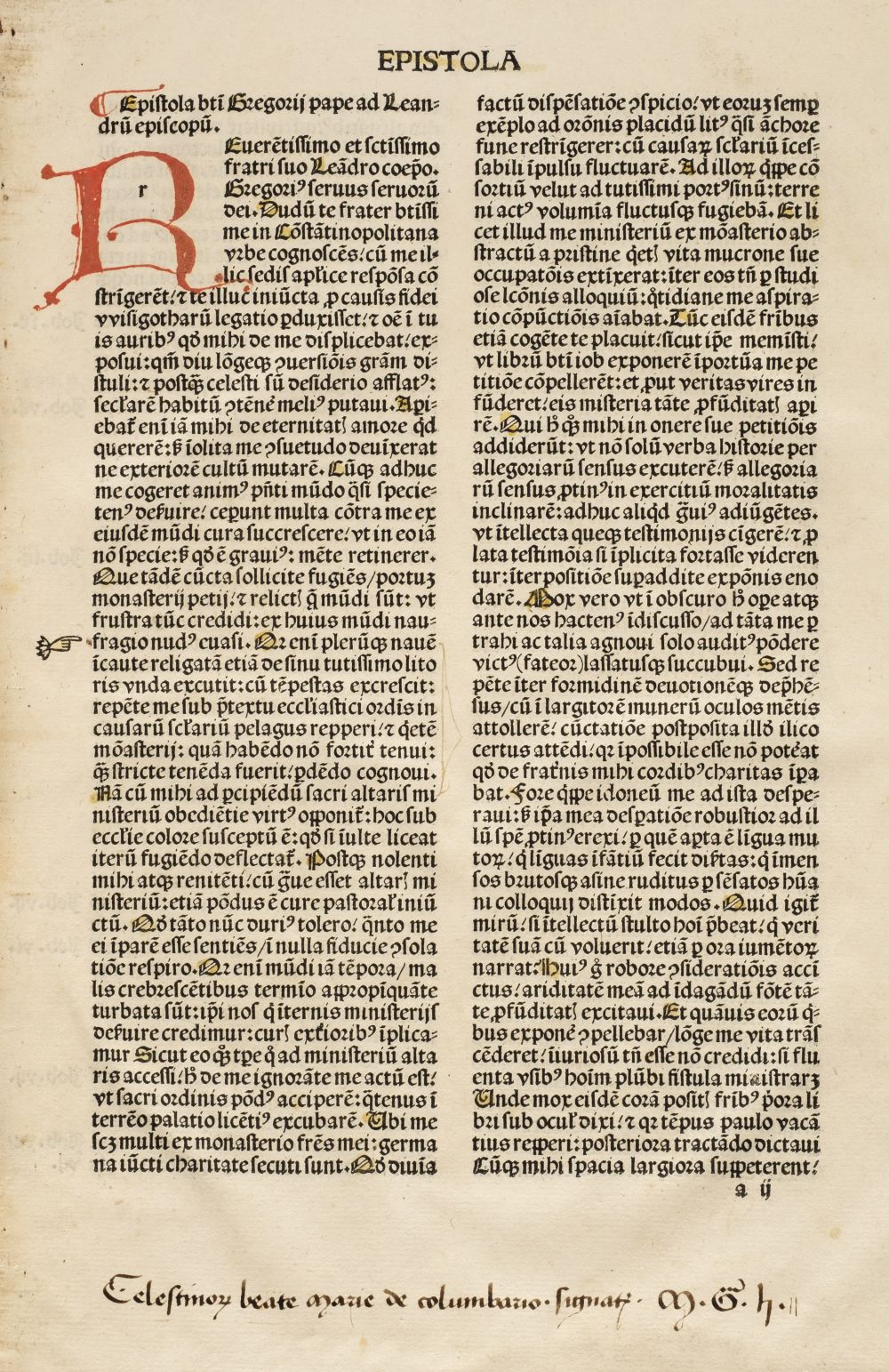GREGORY THE GREAT (c.540-604). Dialogi , in Latin, decorated manuscript on vellum [central Italy, beginning 11th century] 238 x 150mm. 178 leaves: 1 6 (of 8, lacking i and viii), 2-3 8 , 4 7 (of 8, lacking i), 5-6 8 , 7 6 (?of 8, lacking iv and v), 8-22 8 , 23 7 (of 8, lacking viii), lacking further gatherings at end, either 16-17 lines 16-19 lines (ff.1-99) or 28-29 lines written in brown ink in two sizes of caroline bookhand, between a corresponding number of horizontals and two pairs of verticals scored in blind, rubrics, some chapter numbers and initials and the names of the interlocutors in orange, some decorated initials of orange or orange and brown (occasional spotting in margins). Early 19th-century vellum with the title Vite di alcuni S.S. Ancoreti written in black ink. PROVENANCE: 1. The manuscript is written in a number of hands, some showing characteristics of the Italian minuscule, first called Roman minuscule by E.A. Lowe, the 'Farfa type' by W.M. Lindsay, that is the subject of the study by P. Supino Martini, Roma e l'area graphica romanesca (secoli X-XII) , 1987. The general appearance, the flattening of the letters, use of ligatures -- including an exaggerated 'ct', the use of a magiscule for final 's', and the open lower bowl of the 'g' indicate that the manuscript was written in or around Rome early in the 11th century. Bordering the area of the dominance of Beneventan, this location would also account for the Beneventan aspect of one of the hands. 2. Franciscan Convent of Sermoneta, Lazio: 18th-century ownership inscription in lower margin of first folio 3. Library shelfmark H.IV.9 written inside upper cover and 9 written on label at foot of spine CONTENT: Gregory the Great: Dialogi , Book I lacking 5 leaves (first 11 lines up to PL 149, line 11; PL 156, lines 11-38; PL 168, line 55 to 169, line 19; PL 189, line 43 to 192, line 38) ) ff.1-63: Book II ff.63-110v: Book III ff.110v-148: Book IV, chapters 1-37 (of 59, lacking from PL 437, line 7) ff.148-178v: J.P. Migne, Patrologia Latina , lxxvii, Paris, 1849 Probably written in Rome during the early years of his papacy, the Dialogues became the most widely popular of St Gregory's writings. Written in the form of a conversation between Gregory and Peter the Deacon, they tell of the lives and miraculous deeds of St Benedict and other early Latin saints; they became the model for hagiographical collections written throughout the Middle Ages, culminating in the Golden Legend of Jacopo da Voragine. Only one other almost complete codex of a work by Gregory of a similar date has been offered at auction in the past quarter century, the Doheny Moralia on Job sold in these rooms 2 December 1987 (lot 168).
GREGORY THE GREAT (c.540-604). Dialogi , in Latin, decorated manuscript on vellum [central Italy, beginning 11th century] 238 x 150mm. 178 leaves: 1 6 (of 8, lacking i and viii), 2-3 8 , 4 7 (of 8, lacking i), 5-6 8 , 7 6 (?of 8, lacking iv and v), 8-22 8 , 23 7 (of 8, lacking viii), lacking further gatherings at end, either 16-17 lines 16-19 lines (ff.1-99) or 28-29 lines written in brown ink in two sizes of caroline bookhand, between a corresponding number of horizontals and two pairs of verticals scored in blind, rubrics, some chapter numbers and initials and the names of the interlocutors in orange, some decorated initials of orange or orange and brown (occasional spotting in margins). Early 19th-century vellum with the title Vite di alcuni S.S. Ancoreti written in black ink. PROVENANCE: 1. The manuscript is written in a number of hands, some showing characteristics of the Italian minuscule, first called Roman minuscule by E.A. Lowe, the 'Farfa type' by W.M. Lindsay, that is the subject of the study by P. Supino Martini, Roma e l'area graphica romanesca (secoli X-XII) , 1987. The general appearance, the flattening of the letters, use of ligatures -- including an exaggerated 'ct', the use of a magiscule for final 's', and the open lower bowl of the 'g' indicate that the manuscript was written in or around Rome early in the 11th century. Bordering the area of the dominance of Beneventan, this location would also account for the Beneventan aspect of one of the hands. 2. Franciscan Convent of Sermoneta, Lazio: 18th-century ownership inscription in lower margin of first folio 3. Library shelfmark H.IV.9 written inside upper cover and 9 written on label at foot of spine CONTENT: Gregory the Great: Dialogi , Book I lacking 5 leaves (first 11 lines up to PL 149, line 11; PL 156, lines 11-38; PL 168, line 55 to 169, line 19; PL 189, line 43 to 192, line 38) ) ff.1-63: Book II ff.63-110v: Book III ff.110v-148: Book IV, chapters 1-37 (of 59, lacking from PL 437, line 7) ff.148-178v: J.P. Migne, Patrologia Latina , lxxvii, Paris, 1849 Probably written in Rome during the early years of his papacy, the Dialogues became the most widely popular of St Gregory's writings. Written in the form of a conversation between Gregory and Peter the Deacon, they tell of the lives and miraculous deeds of St Benedict and other early Latin saints; they became the model for hagiographical collections written throughout the Middle Ages, culminating in the Golden Legend of Jacopo da Voragine. Only one other almost complete codex of a work by Gregory of a similar date has been offered at auction in the past quarter century, the Doheny Moralia on Job sold in these rooms 2 December 1987 (lot 168).
.jpg)



.jpg)

.jpg)
.jpg)

.jpg?w=400)

.jpg)


Try LotSearch and its premium features for 7 days - without any costs!
Be notified automatically about new items in upcoming auctions.
Create an alert